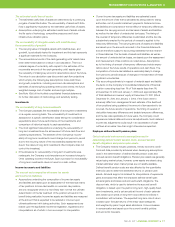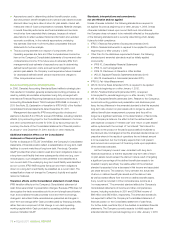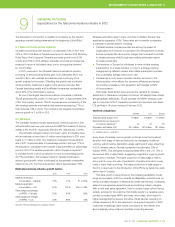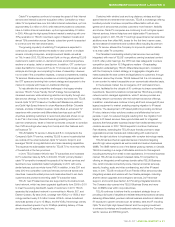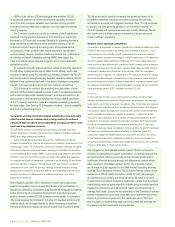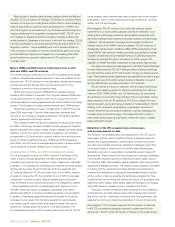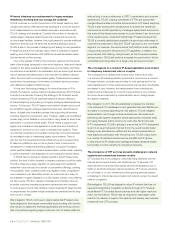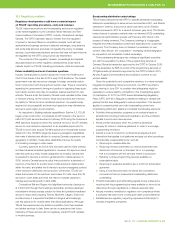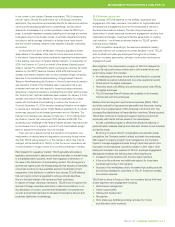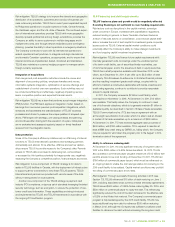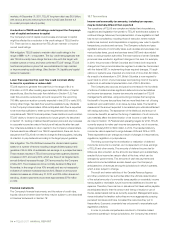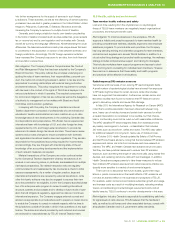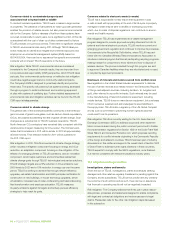Telus 2011 Annual Report Download - page 91
Download and view the complete annual report
Please find page 91 of the 2011 Telus annual report below. You can navigate through the pages in the report by either clicking on the pages listed below, or by using the keyword search tool below to find specific information within the annual report.
TELUS 2011 ANNUAL REPORT . 87
MANAGEMENT’S DISCUSSION & ANALYSIS: 10
and at an opportune time to leverage economies of scale in the manu-
facturing of LTE equipment, given progression in the development of
LTE-capable data devices and smartphones and the need to synchronize
the higher bandwidth capabilities of LTE with the accelerating appetite
of customers for data-rich services. TELUS’ implementation of LTE
technologies is primarily driven by a business case based on the revenue
growth opportunities that this new 4G network provides. In support
of this, TELUS’ wireless network is ready to evolve through software
upgrades to support enhancements in both HSPA+ and LTE that improve
performance, capacity and speed. In parallel, and complementary to
the evolution and growth of HSPA+ and LTE, TELUS continues to develop
a comprehensive capacity management toolkit that will help address
traffic growth challenges and complement new technologies.
Wireless handset supplier concentration and market power
The popularity of certain models of smartphones and tablets from
Apple and RIM has resulted in an increasing reliance on these manu-
facturers, which may increase the market power that these suppliers
have over TELUS.
Risk mitigation: TELUS offers and promotes alternatives, including
Android devices, to provide greater choice for consumers and to help
lessen TELUS’ dependence on a few key suppliers.
Support systems will be increasingly critical
to operational efficiency
TELUS currently has a very large number of interconnected operational
and business support systems, and the complexity is increasing.
This is typical of established telecommunications providers that support
a wide variety of legacy and emerging telephony, mobility, data and
video services. The development and launch of a new service typically
requires significant systems development and integration. The associated
developmental and ongoing operational costs are a significant factor
in maintaining competitive position and profit margins. TELUS is proactive
in evolving to next generation support systems, which leverage industry
integration and process standards. As next generation services are intro-
duced, they must be designed to work with next generation systems
frameworks and IT infrastructures, and at the same time, be compatible
with legacy services and support systems. This introduces uncertainty
with respect to the development and regression test costs and speed to
deliver solutions with the desired effect.
Risk mitigation: In line with industry best practice, TELUS’ approach
is
to separate business support systems (BSS) from operational support
systems (OSS) and underlying network technology. The aim is to decouple
the introduction of new network technologies from the services sold
to customers so that both can evolve independently. This should allow
TELUS to optimize network costs while limiting the impact on customer
services, and facilitate the introduction of new services by driving BSS/
OSS functions with configurable data rather than programmatic changes.
In addition, TELUS is an active participant in the TeleManagement
Forum that is working to develop standard industry-defined modules
in order to reduce cost through scale and increase adoption through
scope. TELUS has established a next generation BSS/OSS framework
to ensure that, as new services and technologies are developed, they
are part of the next generation framework to ease the retirement of legacy
systems in accordance with TeleManagement Forum’s Next Generation
Operations Systems and Software program.
Restructuring of equipment vendors may impact
TELUS networks and services
TELUS has relationships with a number of equipment vendors, which
are important in supporting network evolution plans and timelines and
providing services to the Company’s customers. TELUS faces the risk
that some equipment vendors may experience business difficulties,
may not remain viable or may restructure their operations, which could
affect their ability to support all of their products in the future.
Risk mitigation: TELUS considers these possible outcomes when plan
-
ning for its future growth, maintenance and support of existing equipment
and services. The Company has a comprehensive contingency plan
for multiple scenarios, including working with multiple suppliers and
main taining ongoing strong vendor relations. However, there can be no
guarantee that the outcome of any particular vendor difficulty will not
affect the services that TELUS provides to its customers, or that TELUS
will not incur additional costs to continue providing services.
Evolving wired broadband access technology standards may
outpace projected access infrastructure investment lifetimes
The technology standards for broadband access over copper loops
to customer premises are evolving rapidly, enabling higher broadband
access speeds. The evolution is fuelled by user appetite for faster
connectivity, the threat of increasing competitor capabilities and offerings,
and the desire of service providers like TELUS to offer new services,
such as IP TV, that require greater bandwidth. In general, the evolution to
higher broadband access speeds is achieved by deploying fibre further
out from the central office, thus shortening the copper loop portion of
the access network, and using faster modem technologies on the short-
ened copper loop. However, new access technologies are evolving
faster than the traditional investment cycle for access infrastructure. The
introduction of these new technologies and the pace of adoption could
result in increased requirements for capital funding not currently planned,
as well as shorter estimated useful lives for certain existing infrastructure,
which would increase depreciation and amortization expenses.
Risk mitigation: TELUS actively monitors the development and carrier
acceptance of competing proposed FTTx standards (such as fibre
to the home, or FTTH, and fibre to the neighbourhood, or FTTN). One
or more of these fibre-based solutions may be a more practical technol-
ogy to deploy in brownfield neighbourhoods or multiple dwelling units
(MDUs) than the current xDSL deployments on copper loops. TELUS is
exploring business models for the economical deployment of fibre-based
technologies in areas currently connected by copper.
As part of its multi-year broadband build program, TELUS has been
upgrading its network to IP-based digital subscriber line access multi-
plexers (DSLAMs) with ADSL2+ technology, which enables down link
rates of up to 15 Mbps to the customer premises. In 2009, TELUS began
upgrading this IP DSLAM deployment to VDSL2 technology in certain
urban areas to extend the capabilities of the copper loops and double
previ ous speeds. VDSL2 technology enables typical down link rates of up
to 30 Mbps, is backward-compatible with ADSL and ADSL2+ and takes
advantage of TELUS’ investments in extended reach copper/fibre access
infrastructure. The VDSL2 upgrade was substantially completed in 2011.
The evolution of these access architectures and corresponding
standards, enabled with quality of service standards and network traffic
engineering, all support the TELUS Future Friendly Home strategy
to deliver IP-based Internet, voice and video services over a common
broadband access infrastructure.


